统编初一年级英语下册电子教案七下Unit 4三3课时
- 格式:doc
- 大小:551.22 KB
- 文档页数:10
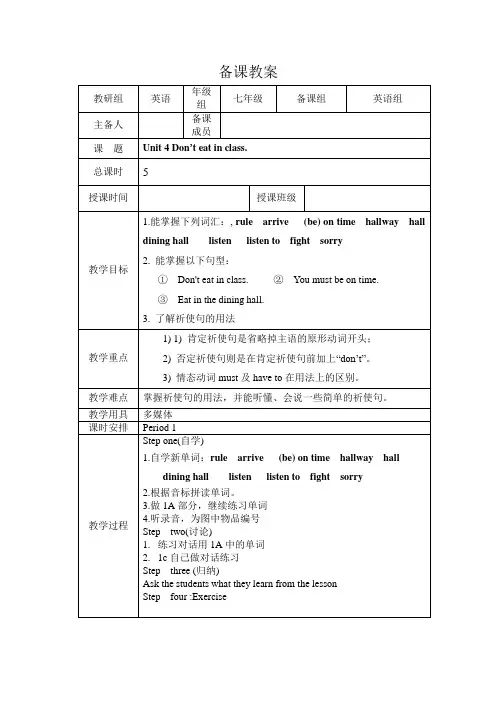
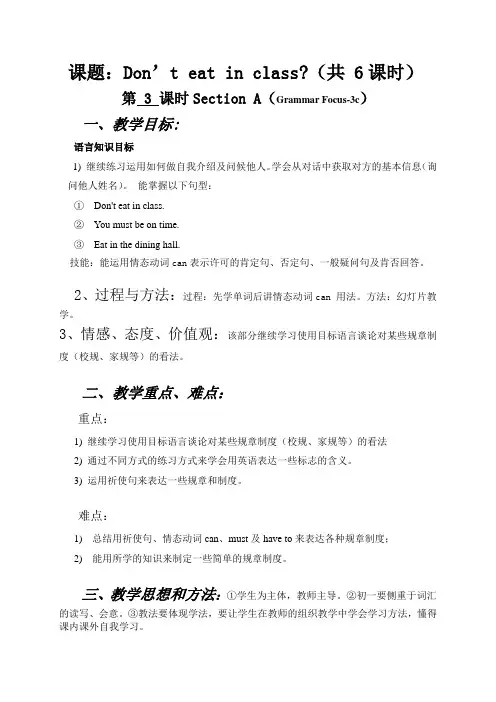
课题:Don’t eat in class?(共 6课时)第 3 课时Section A(Grammar Focus-3c)
一、教学目标:
语言知识目标
1) 继续练习运用如何做自我介绍及问候他人。
学会从对话中获取对方的基本信息(询问他人姓名)。
能掌握以下句型:
①Don't eat in class.
②You must be on time.
③Eat in the dining hall.
技能:能运用情态动词can表示许可的肯定句、否定句、一般疑问句及肯否回答。
2、过程与方法:过程:先学单词后讲情态动词can 用法。
方法:幻灯片教学。
3、情感、态度、价值观:该部分继续学习使用目标语言谈论对某些规章制度(校规、家规等)的看法。
二、教学重点、难点:
重点:
1) 继续学习使用目标语言谈论对某些规章制度(校规、家规等)的看法
2) 通过不同方式的练习方式来学会用英语表达一些标志的含义。
3) 运用祈使句来表达一些规章和制度。
难点:
1) 总结用祈使句、情态动词can、must及have to来表达各种规章制度;
2) 能用所学的知识来制定一些简单的规章制度。
三、教学思想和方法:①学生为主体,教师主导。
②初一要侧重于词汇
的读写、会意。
③教法要体现学法,要让学生在教师的组织教学中学会学习方法,懂得课内课外自我学习。
四、教学关键:如何让学生在课堂上积极主动,做到学什么就能理解、掌握和记住什么。
五、教学准备:
1、教师准备:幻灯片
2、学生准备:预习单词
六、教学过程设计。
![[七年级(下)Unit4教案]七年级下unit4教案](https://uimg.taocdn.com/c6241cff4431b90d6d85c728.webp)
[七年级(下)Unit4教案]七年级下unit4教案<b style=“mso-bidi-font-weight: normal“>七年级英语公开课教案<b style="mso-bidi-font-weight: normal"> <o:p></o:p><b style="mso-bidi-font-weight: normal"><b style="mso-bidi-font-weight: normal">课<b style="mso-bidi-font-weight: normal"><b style="mso-bidi-font-weight: normal">题<b style="mso-bidi-font-weight: normal"><b style="mso-bidi-font-weight: normal">七年级(下)Unit4 Section A <st1:chmetcnv w:st="on" unitname="a" sourcevalue="1" hasspace="false" negative="false" numbertype="1" tcsc="0"> 1a </st1:chmetcnv> <st1:chmetcnv w:st="on" unitname="c" sourcevalue="1" hasspace="false" negative="true" numbertype="1" tcsc="0"> -1c </st1:chmetcnv><b style="mso-bidi-font-weight: normal"><b style="mso-bidi-font-weight: normal">课型<b style="mso-bidi-font-weight: normal"><b style="mso-bidi-font-weight: normal">新课<b style="mso-bidi-font-weight: normal"><b style="mso-bidi-font-weight: normal">课<b style="mso-bidi-font-weight: normal"><b style="mso-bidi-font-weight: normal">时<b style="mso-bidi-font-weight: normal"><b style="mso-bidi-font-weight: normal">1<b style="mso-bidi-font-weight: normal"><b style="mso-bidi-font-weight: normal">授课<b style="mso-bidi-font-weight: normal"><b style="mso-bidi-font-weight: normal">时间<b style="mso-bidi-font-weight: normal"><b style="mso-bidi-font-weight: normal"> <o:p></o:p><b style="mso-bidi-font-weight: normal"><b style="mso-bidi-font-weight: normal">授课班级<b style="mso-bidi-font-weight: normal"><b style="mso-bidi-font-weight: normal"> <o:p></o:p><b style="mso-bidi-font-weight: normal"><b style="mso-bidi-font-weight: normal">授课地点<b style="mso-bidi-font-weight: normal"><b style="mso-bidi-font-weight: normal"> <o:p></o:p><b style="mso-bidi-font-weight: normal"><b style="mso-bidi-font-weight: normal">授课人<b style="mso-bidi-font-weight: normal"><b style="mso-bidi-font-weight: normal"> <o:p></o:p><b style="mso-bidi-font-weight: normal"><b style="mso-bidi-font-weight: normal">教<b style="mso-bidi-font-weight: normal"><b style="mso-bidi-font-weight: normal">学<b style="mso-bidi-font-weight: normal"><b style="mso-bidi-font-weight: normal">目<b style="mso-bidi-font-weight: normal"><b style="mso-bidi-font-weight: normal">标<b style="mso-bidi-font-weight: normal"><b style="mso-bidi-font-weight: normal">知识与能力<b style="mso-bidi-font-weight: normal"><b style="mso-bidi-font-weight: normal">1, words: assistant. sales assistant. doctor. reporter. police. officer. police officer. waiter. bank. clerk. hospital. show. star<b style="mso-bidi-font-weight: normal"><b style="mso-bidi-font-weight: normal">2. What do you want to be? 3. What does she do?<b style="mso-bidi-font-weight: normal"><b style="mso-bidi-font-weight: normal">I want to be a doctor. She’s a doctor.<b style="mso-bidi-font-weight: normal"><b style="mso-bidi-font-weight: normal">过程与方法<b style="mso-bidi-font-weight: normal"><b style="mso-bidi-font-weight: normal">师生互动,共同完成教学目标。
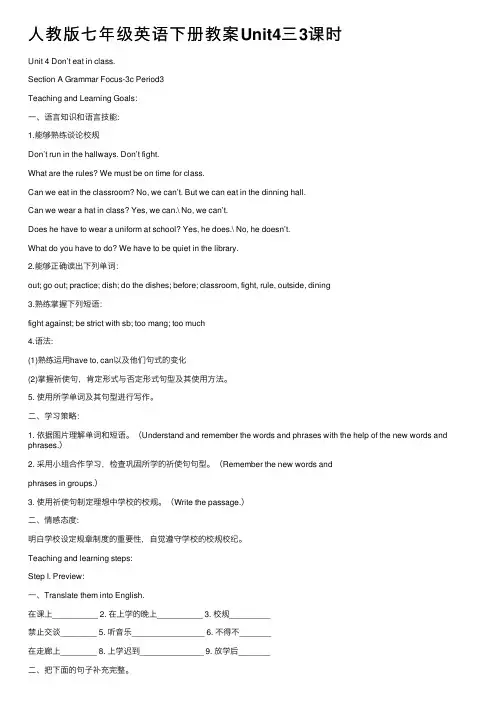
⼈教版七年级英语下册教案Unit4三3课时Unit 4 Don’t eat in class.Section A Grammar Focus-3c Period3Teaching and Learning Goals:⼀、语⾔知识和语⾔技能:1.能够熟练谈论校规Don’t run in the hallways. Don’t fight.What are the rules? We must be on time for class.Can we eat in the classroom? No, we can’t. But we can eat in the dinning hall.Can we wear a hat in class? Yes, we can.\ No, we can’t.Does he have to wear a uniform at school? Yes, he does.\ No, he doesn’t.What do you have to do? We have to be quiet in the library.2.能够正确读出下列单词:out; go out; practice; dish; do the dishes; before; classroom, fight, rule, outside, dining3.熟练掌握下列短语:fight against; be strict with sb; too mang; too much4.语法:(1)熟练运⽤have to, can以及他们句式的变化(2)掌握祈使句,肯定形式与否定形式句型及其使⽤⽅法。
5. 使⽤所学单词及其句型进⾏写作。
⼆、学习策略:1. 依据图⽚理解单词和短语。
(Understand and remember the words and phrases with the help of the new words and phrases.)2. 采⽤⼩组合作学习,检查巩固所学的祈使句句型。
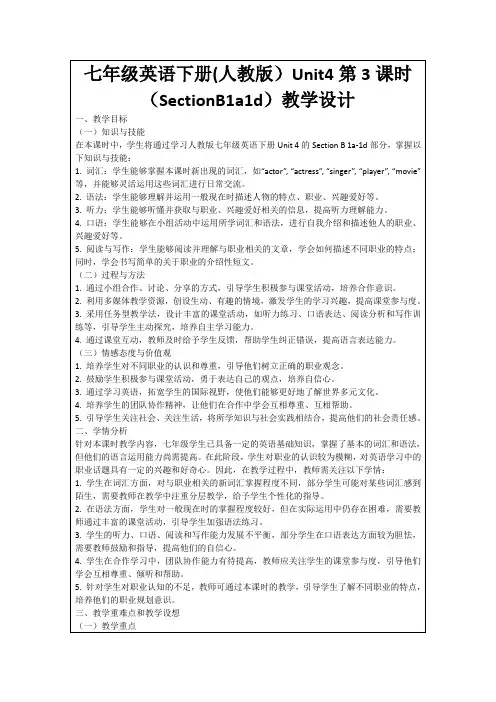
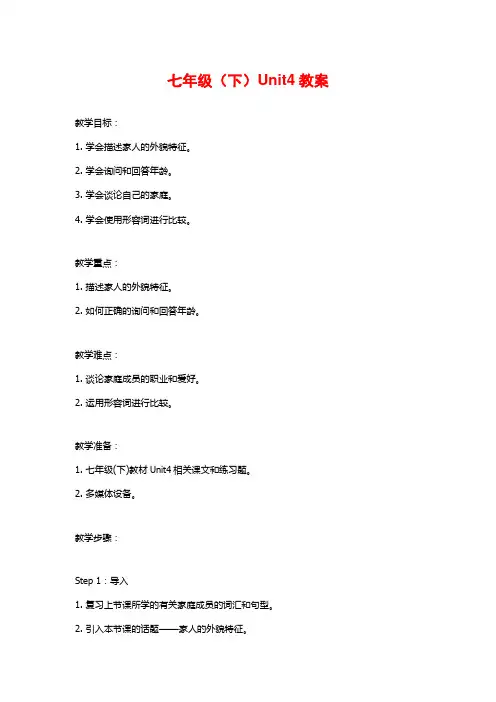
七年级(下)Unit4教案教学目标:1. 学会描述家人的外貌特征。
2. 学会询问和回答年龄。
3. 学会谈论自己的家庭。
4. 学会使用形容词进行比较。
教学重点:1. 描述家人的外貌特征。
2. 如何正确的询问和回答年龄。
教学难点:1. 谈论家庭成员的职业和爱好。
2. 运用形容词进行比较。
教学准备:1. 七年级(下)教材Unit4相关课文和练习题。
2. 多媒体设备。
教学步骤:Step 1:导入1. 复习上节课所学的有关家庭成员的词汇和句型。
2. 引入本节课的话题——家人的外貌特征。
Step 2:呈现1. 展示图片或描述家庭成员的外貌特征,让学生听与看并回答问题。
2. 多媒体呈现部分相关课文,让学生跟读。
Step 3:练习1. 运用展示的图片或相关的描述,让学生进行口头描述。
学生之间可以互相猜测描述的对象是谁。
2. 让学生自由搭配人物和特征进行描述。
Step 4:听说训练1. 播放相关录音,学生跟读。
2. 学生之间进行小组对话,询问和回答有关外貌特征的问题。
3. 整班展示,让其他学生猜测描述的对象。
Step 5:语法讲解1. 复习询问和回答年龄的表达方式。
2. 解释形容词比较级和最高级的用法。
Step 6:练习1. 进行口头练习,让学生询问和回答年龄。
2. 进行图画描述比较,让学生说出每个人的外貌特征并做比较。
Step 7:写作训练1. 提供一个图片或相关的描述,让学生以此为基础写一篇关于家庭的作文。
Step 8:巩固与拓展1. 布置相关练习题,让学生进行书面练习。
2. 教师进行总结,并给予学生积极的反馈。
Step 9:作业布置1. 完成相关练习题。
2. 准备下一节课的学习内容。
Step 10:课堂结束1. 进行课堂总结,巩固学生的学习成果。
2. 鼓励学生继续努力,准备好下一节课的学习。
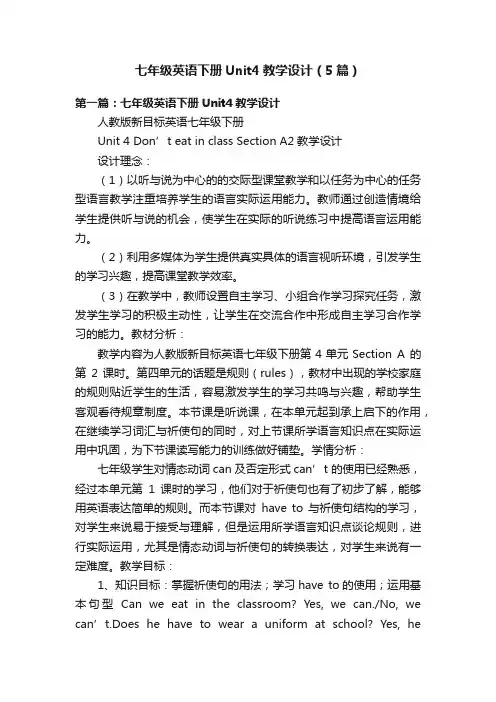
七年级英语下册Unit4教学设计(5篇)第一篇:七年级英语下册Unit4教学设计人教版新目标英语七年级下册Unit 4 Don’t eat in class Section A2教学设计设计理念:(1)以听与说为中心的的交际型课堂教学和以任务为中心的任务型语言教学注重培养学生的语言实际运用能力。
教师通过创造情境给学生提供听与说的机会,使学生在实际的听说练习中提高语言运用能力。
(2)利用多媒体为学生提供真实具体的语言视听环境,引发学生的学习兴趣,提高课堂教学效率。
(3)在教学中,教师设置自主学习、小组合作学习探究任务,激发学生学习的积极主动性,让学生在交流合作中形成自主学习合作学习的能力。
教材分析:教学内容为人教版新目标英语七年级下册第4单元Section A 的第2课时。
第四单元的话题是规则(rules),教材中出现的学校家庭的规则贴近学生的生活,容易激发学生的学习共鸣与兴趣,帮助学生客观看待规章制度。
本节课是听说课,在本单元起到承上启下的作用,在继续学习词汇与祈使句的同时,对上节课所学语言知识点在实际运用中巩固,为下节课读写能力的训练做好铺垫。
学情分析:七年级学生对情态动词can及否定形式can’t 的使用已经熟悉,经过本单元第1课时的学习,他们对于祈使句也有了初步了解,能够用英语表达简单的规则。
而本节课对have to 与祈使句结构的学习,对学生来说易于接受与理解,但是运用所学语言知识点谈论规则,进行实际运用,尤其是情态动词与祈使句的转换表达,对学生来说有一定难度。
教学目标:1、知识目标:掌握祈使句的用法;学习have to的使用;运用基本句型Can we eat in the classroom? Yes, we can./No, we can’t.Does he have to wear a uniform at school? Yes, hedoes./No, he doesn’t.What do we have to do? We have to be quiet in the library.谈论学校、图书馆规则。
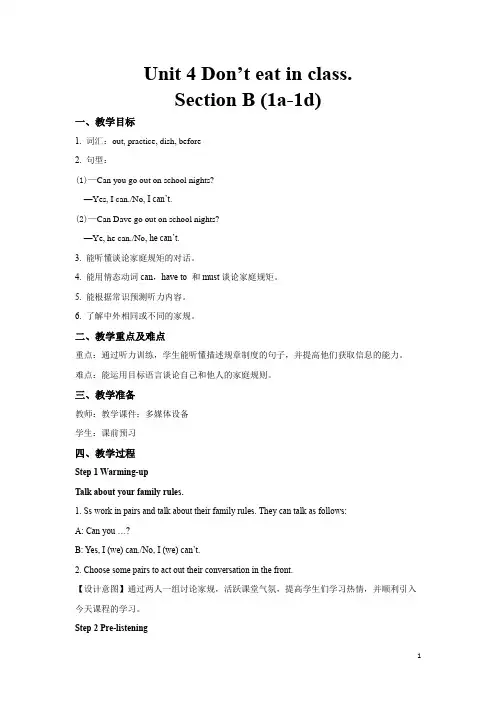
Unit 4 Don’t eat in class.Section B (1a-1d)一、教学目标1. 词汇:out, practice, dish, before2. 句型:(1)—Can you go out on school nights?—Yes, I can./No, I can’t.(2)—Can Dave go out on school nights?—Ye, he can./No, he can’t.3. 能听懂谈论家庭规矩的对话。
4. 能用情态动词can,have to 和must谈论家庭规矩。
5. 能根据常识预测听力内容。
6. 了解中外相同或不同的家规。
二、教学重点及难点重点:通过听力训练,学生能听懂描述规章制度的句子,并提高他们获取信息的能力。
难点:能运用目标语言谈论自己和他人的家庭规则。
三、教学准备教师:教学课件;多媒体设备学生:课前预习四、教学过程Step 1 Warming-upTalk about your family rules.1. Ss work in pairs and talk about their family rules. They can talk as follows:A: Can you …?B: Yes, I (we) can./No, I (we) can’t.2. Choose some pairs to act out their conversation in the front.【设计意图】通过两人一组讨论家规,活跃课堂气氛,提高学生们学习热情,并顺利引入今天课程的学习。
Step 2 Pre-listeningWords and expressions1. T leads Ss to read the new words and expressions.2. Ss read them individually.3. T asks some Ss to read the new words and expressions, and check their pronunciation.【设计意图】让学生熟悉新词汇,为后面的学习做铺垫。
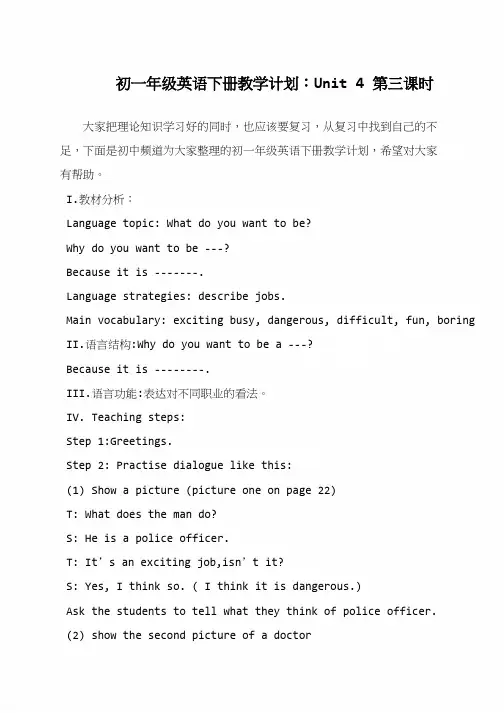
初一年级英语下册教学计划:Unit 4 第三课时大家把理论知识学习好的同时,也应该要复习,从复习中找到自己的不足,下面是初中频道为大家整理的初一年级英语下册教学计划,希望对大家有帮助。
I.教材分析: Language topic: What do you want to be? Why do you want to be ---? Because it is -------. Language strategies: describe jobs. Main vocabulary: exciting busy, dangerous, difficult, fun, boring II.语言结构:Why do you want to be a ---? Because it is --------. III.语言功能:表达对不同职业的看法。
IV. Teaching steps: Step 1:Greetings. Step 2: Practise dialogue like this: (1) Show a picture (picture one on page 22) T: What does the man do? S: He is a police officer. T: It’s an exciting job,isn’t it? S: Yes, I think so. ( I think it is dangerous.) Ask the students to tell what they think of police officer. (2) show the second picture of a doctor。
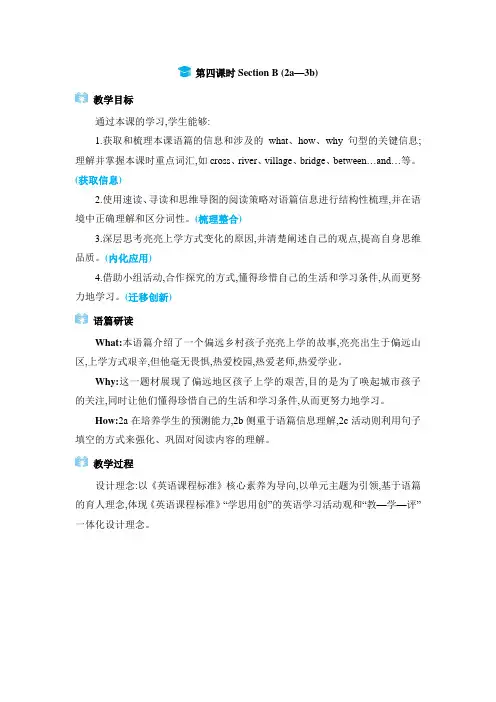
第四课时Section B (2a—3b)教学目标通过本课的学习,学生能够:1.获取和梳理本课语篇的信息和涉及的what、how、why句型的关键信息;理解并掌握本课时重点词汇,如cross、river、village、bridge、between…and…等。
(获取信息)2.使用速读、寻读和思维导图的阅读策略对语篇信息进行结构性梳理,并在语境中正确理解和区分词性。
(梳理整合)3.深层思考亮亮上学方式变化的原因,并清楚阐述自己的观点,提高自身思维品质。
(内化应用)4.借助小组活动,合作探究的方式,懂得珍惜自己的生活和学习条件,从而更努力地学习。
(迁移创新)语篇研读What:本语篇介绍了一个偏远乡村孩子亮亮上学的故事,亮亮出生于偏远山区,上学方式艰辛,但他毫无畏惧,热爱校园,热爱老师,热爱学业。
Why:这一题材展现了偏远地区孩子上学的艰苦,目的是为了唤起城市孩子的关注,同时让他们懂得珍惜自己的生活和学习条件,从而更努力地学习。
How:2a在培养学生的预测能力,2b侧重于语篇信息理解,2c活动则利用句子填空的方式来强化、巩固对阅读内容的理解。
教学过程设计理念:以《英语课程标准》核心素养为导向,以单元主题为引领,基于语篇的育人理念,体现《英语课程标准》“学思用创”的英语学习活动观和“教—学—评”一体化设计理念。
板书设计作业设计基础型作业:Read and recite the key words, phrases and sentences in the class.实践型作业:Finish and polish your passage after class.拓展型作业:Search how children in the world get to school on the Internet and makea report.教学反思。
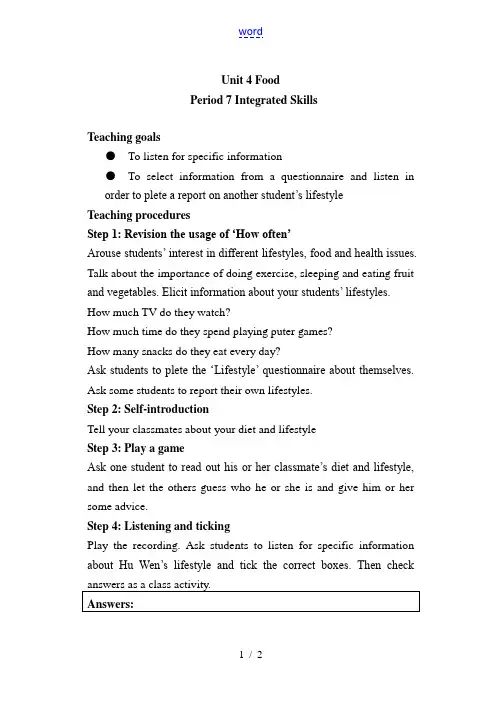
Unit 4 FoodPeriod 7 Integrated SkillsTeaching goals●To listen for specific information●To select information from a questionnaire and listen inorder to plete a report on another student’s lifestyleTeaching proceduresStep 1: Revision the usage of ‘How often’Arouse students’ interest in different lifestyles, food and health issues. Talk about the importance of doing exercise, sleeping and eating fruit and vegetables. Elicit information about your students’ lifestyles. How much TV do they watch?How much time do they spend playing puter games?How many snacks do they eat every day?Ask students to plete the ‘Lifestyle’ questionnaire about themselves. Ask some students to report their own lifestyles.Step 2: Self-introductionTell your classmates about your diet and lifestyleStep 3: Play a gameAsk one student to read out his or her classmate’s diet and lifestyle, and then let the others guess who he or she is and give him or her some advice.Step 4: Listening and tickingPlay the recording. Ask students to listen for specific information about Hu Wen’s lifestyle and tick the correct boxes. Then checkStep 5: Extension activitiesAsk students to enter Hu Wen’s score and their own score in the table in Part A3. Students analyze the health scores for Hu Wen and themselves. Read out three categories. Ask students to put up their hands for each category. Count the number of students in each category to see how healthy or unhealthy the class is.Write a class profile on the blackboard with the number of students for each category. Students could put up this information for class display.Step 6: Making an interviewWork in pairs, ask each other the questions in Part A4. Then work out partners’ health score. And write a r eport on him/her (Part A5).Step 7: DiscussionAsk students to give some suggestions to their partners according to their health reports. Tell them how to be healthier.Step 8: Making a summaryT: In this period, we’ve known more about our own health infor mation and our partners’ by pleting a ‘Lifestyle’ questionnaire. And we’ve talked about how to be healthier.Step 9: HomeworkOral work: Go on with the questionnaire, do it with your families. Written work: Teachers can assign this part according to their own conditions.。
单元题目Unit4 Don’t eat in class.听说课第四课时Section B (1a-1d)Teaching and learning Goals一、语言知识:1.熟练掌握以下词汇和短语:out, go out, practice, dish, do the dishes, before.2.熟练掌握以下句型:-Can Dave go out on school nights? –Yes, he can. / No, he ca n’t.二、语言功能:Talk about the rules in Dave’s house.三、学习策略能根据常识预测听力内容。
四、情感态度Enable students to obey the rules and to be a good student.(设计意图:目标引领,用一段话表述了本节课的知识、能力和情感目标,学生能够快速领略本课核心。
)Preview:Task1. Look at P22, put the following into English orally, and then write them down without looking at books.1.外出______________________________________2. 看望朋友__________________________________3. 做家庭作业_______________________________4. 练习吉他__________________________________5. 洗餐具____________________________________6. 看电视_____________________________________7. 帮助妈妈做早饭_____________________________8. 打扫房间___________________________________Task2. Put the following into Chinese.1.I can’t go out on school nights.________________________2.What other rules do you have?_________________________3.I must practice the guitar before dinner.__________________4.That’s too bad.___________________________________5.You do have a lot of rules!________________________(设计意图:通过预习检测这个环节,既培养学生课前预习的能力,同时预习题的设计都来源于文中的重点短语和句子,为学生的听力和对话扫除障碍。
七下Unit4英语教案一、页七年级下册英语第四单元教案二、目录1.页2.目录3.摘要4.背景和现状分析1.教学大纲要求2.学生学习现状3.教学资源与环境5.项目目标1.知识与技能目标2.过程与方法目标3.情感态度与价值观目标6.教学设计1.教学方法2.教学内容3.教学评价7.教学活动1.导入活动2.主体教学活动8.作业与反馈9.教学资源10.附录三、摘要本教案为七年级下册英语第四单元的教学设计,旨在通过多样化的教学方法和活动,提高学生对英语学习的兴趣和积极性,同时培养他们的英语听说读写能力。
教案以教材内容为基础,结合学生的实际情况,制定了具体的教学目标和计划,确保教学活动的有效性。
四、背景和现状分析1.1教学大纲要求根据国家英语课程标准,七年级学生的英语学习应达到一定的水平,包括掌握基础词汇和语法,能够进行简单的日常对话,以及具备初步的阅读和写作能力。
本单元的教学内容涉及日常生活中的常见场景,与学生的实际生活紧密相关,有助于提高他们的英语应用能力。
2.1学生学习现状经过上半学期的学习,七年级学生在英语学习方面已具备一定的基础,但在听说方面仍存在一定的困难。
学生的学习兴趣和积极性也有所差异,需要通过不同的教学方法和活动来激发他们的学习兴趣。
3.1教学资源与环境学校提供了一定的教学资源,包括教材、多媒体设备等,但仍有待进一步开发和利用。
教学环境方面,班级人数较多,需要通过合理的教学设计和组织来保证每个学生都有参与和展示的机会。
五、项目目标1.1知识与技能目标学生能够掌握本单元的核心词汇和语法结构;学生能够运用所学知识进行简单的日常对话;学生能够阅读并理解与本单元相关的短文。
2.1过程与方法目标学生能够通过参与课堂活动,提高英语听说能力;学生能够通过合作学习,培养团队协作能力;学生能够通过自主学习,提高解决问题的能力。
3.1情感态度与价值观目标学生能够增强对英语学习的兴趣和自信心;学生能够尊重和欣赏不同的文化和观点。
Unit 4Don’t eat in class!The Third PeriodSection A (Grammar Focus-3c)I.Teaching aimsImportant sentences:①—Can we eat in the classroom?—No,we can’t,but we can eat in the dining hall.②What do you have to do?③Don’t fight.II.Important points:1.祈使句2.情态动词can,can’t和have to的用法III.Difficult points:1.祈使句2.情态动词can,can’t和have to的用法IV.Teaching processStep 1 Lead inTeacher:Can we listen to music in class?Students:No,we can't.Teacher:Do we have to arrive school on time?Students:Yes,we do....Step 2 Work on Grammar Focus1.教师通过板书呈现大量祈使句及含can,can’t,have to的句型,让学生观察讨论。
2.学生先自己阅读Grammar Focus的内容。
老师详细讲解语法要点。
Step 3 Work on 3a-3c1.认真观察图片,用所学的祈使句句型为学校图书馆写出一些规定,写完后小组内交流,教师抽查点评。
2.利用所给的单词或短语来组成关于学校规定的句子,然后根据学校的实际情况来回答。
请学生在黑板上展示答案。
3.写五条理想学校的校规,然后和其他同学分享,选出最受欢迎的校规。
4.利用所选出的校规来写一篇小短文。
Language points1.Don’t fight.不要打架。
(教材第21页)fight此处用作动词,意为“打架;战斗”。
Unit 4 Don't eat in class.单元要览本单元的话题是“规则”,功能为“谈论规则”。
通过本单元的教学,要引导学生掌握重点句式Don't…和Can…?并学会运用本单元所学的词汇和句式谈论不同场所的各种规则,培养良好的社会公共道德。
本单元的教学内容见下表。
本单元的课时安排与具体教学建议如下Period l Section A( la-lc )I.教学准备1.教师:制作课件;准备录音机、磁带和la部分的教学挂图。
2.学生:搜集一些常见的标识,并画在纸上。
Ⅱ,教学目标1.通过看图会话、师生问答、听录音、角色扮演等形式,掌握arrive,listen,fight和rule,sorry等词。
2.通过师生问答、角色扮演等形式,学会“Don't+动词原形”以及“We can't/must…‟等句子结构,并能用英语谈论、描述学校里的规章制度。
Ⅲ.教学重点1.本课时出现的arrive,listen,fight,rule,sorry.等词;2.祈使句。
Ⅳ.教学难点1.can表示请求的用法;2.must表示命令或建议的用法。
V.教学步骤Step I: Revision & Warming-up建议1:通过师生自由交际进行复习与热身。
教师问学生一些事情能不能做,为导入新课做准备。
For example:T: Can we play football in the street?Sl: No, we can't.T: Yes. Don't play football in the street. It's dangerous. Can we sleep in class?S2: No, we can't.T: Yes, you are right. Don't sleep in class.建议2:教师呈现一组禁止标识,通过谈论这些标识进行课前热身。
Unit 4 Don’t eat in class.Section A Grammar Focus-3c Period3Teaching and Learning Goals:一、语言知识和语言技能:1.能够熟练谈论校规Don’t run in the hallways. Don’t fight.What are the rules? We must be on time for class.Can we eat in the classroom? No, we can’t. But we can eat in the dinning hall.Can we wear a hat in class? Yes, we can.\ No, we can’t.Does he have to wear a uniform at school? Yes, he does.\ No, he doesn’t.What do you have to do? We have to be quiet in the library.2.能够正确读出下列单词:out; go out; practice; dish; do the dishes; before; classroom, fight, rule, outside, dining3.熟练掌握下列短语:fight against; be strict with sb; too mang; too much4.语法:(1)熟练运用have to, can以及他们句式的变化(2)掌握祈使句,肯定形式与否定形式句型及其使用方法。
5. 使用所学单词及其句型进行写作。
二、学习策略:1. 依据图片理解单词和短语。
(Understand and remember the words and phrases with the help of the new words and phrases.)2. 采用小组合作学习,检查巩固所学的祈使句句型。
(Remember the new words andphrases in groups.)3. 使用祈使句制定理想中学校的校规。
(Write the passage.)二、情感态度:明白学校设定规章制度的重要性,自觉遵守学校的校规校纪。
Teaching and learning steps:Step I. Preview:一、Translate them into English.在课上__________ 2. 在上学的晚上__________ 3. 校规_________禁止交谈________ 5. 听音乐________________ 6. 不得不_______在走廊上________ 8. 上学迟到______________ 9. 放学后_______二、把下面的句子补充完整。
1.你们学校有什么规定?What are the ____________in your school.2.请勿在走廊上追逐也不要上课迟到。
Don’t run and don’t _____________ class.3.我们可以在学校吃东西吗?Can we _______________in school?4.我们可以在食堂吃东西但不可以在课室吃。
We can eat in the _____, but we can't eat5.你们必须在学校穿制服吗?是的,我们要穿。
Do you ___________ at school? Yes, ______ _______.6.我们还有什么必须得做吗?你们必须打扫课室。
What do we have to do? You have to _____________.(设计说明:课前就布置给学生,提前熟悉词组和句子,有重点,有目的的预习可以为本节课的学习扫除障碍,通过习题的训练,是学生有针对性的学,同时可以检测学生的预习效果。
)StepⅡ.Warming up and leading in热身导入1.Lead-in“His name is Xiaoxin. He is a new student. You are xiaoxin’s new classmates, please tell him what are the school rules.”1. Ask the students to ask and answer in pairs.Can I run in the hallways? No, you can’t.Can I wear a hat in class? No, you can’t.Don’t run in the hallways. Don’t wear a hat in class.Can I fight? No, you can’t.Don’t fight.Can I eat in class? No, you don’t.Don’t eat in class.Can I sleep in class? No, you don’t.Don’t sleep in class.What do I have to do? You must be on time for class.You must wear a uniform at school. 2. “Do you know other school rules? Please tell Xiaoxin.” Ask the students to talk in groups.(设计意图:通过学生喜闻乐见的卡通人物图片展示,给学生们创设易于理解和表达的语境,抓住学生的注意力。
又通过介绍小新是学校的新同学,要求学生给小新介绍学校的校规校纪导入,巩固校规的表达方法,从而熟悉句型和can, have to的用法。
)StepⅢ.Grammar FocusSum up:Let the students make conversations.What are the rules?We must be on time for class.Can we eat in the classroom? No, we can’t. but we can eat in the dinning hall. Can we wear a hat in class?Yes, we can.\ No, we can’t.Does he have to wear a uniform at school? Yes, he does.\ No, he doesn’t.What do you have to do?We have to be quiet in the library.Can we run in the hallways?Yes, we can.\ No, we can’t.(设计意图:通过本项训练,旨在培养学生获取知识善于总结的能力,并能通过做对话练习中训练重点和难点。
)StepIV Ask some students to write them down on the blackboard“Xiaoxin wants to know what are the rules in the library. Can you tell him?”3a. Write the rules for the school library.Don’t talk.Don’t eat in the library.Don’ttalk.Don’t listen to music.Don’t take photos. Library Rules1.Don’t talk.2. Don’t eat in the library.3. Don’t listen to music.4. Don’t take photos.3b Use the words to make questions about the rules. Then write answers according to your school.Be quiet?Q: ___________________________________ (she / have to / in the library)?A: ___________________________________Eat?Q: ___________________________________ (he / have to / in the dining hall)?A: ___________________________________Listen to music?Q: ___________________________________ (we / can / in the hallways)?A: ___________________________________Wear a hat?Q: ___________________________________ (we / can / in the classroom)?A: ___________________________________StepV Report(1) Make up five cool rules for your dream school. Share your rules with the class. Yourclassmates vote for the Coolest School!1. We can eat in class.2. We don’t have to come to school every day.3. …(2) A report. “My Coolest school.”At my dream school, we don’t have to come to school every day. We can eat in the classroom. We can listen to music in class. We don’t have to do homework. We don’t have to wear the school uniform at school...(设计意图:本环节是对知识点的灵活运用,句子可以让学生到黑板上去写,规范一下学生的书写,以及一些注意事项和学生容易出错的地方,然后用之前学习过的句子准备一篇作文:我理想的学校,既巩固了知识点的运用,也锻炼了学生的口头表达,提升了学生的个人能力。